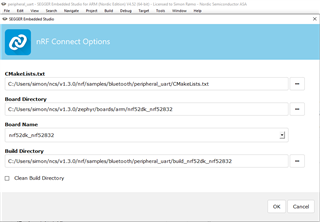Hello NRF,
I have a custom board with NRF52832, and exposed the SWDIO, SWDCLK, GND, VDD, RESET pins for programming the board through the NRF52-DK board.
I started with a sample peripheral_uart, connected the NRF52-DK board to my PC, and managed to BUILD and RUN the sample application.
I verified that the app is working, by connecting to the UART service advertised by this app (on NRF52-DK) through another device that has NRF-TOOLBOX and used the UART service to query the NRF UART (NRF52-DK board) and managed to read write and verified the same over the console.
Now, I want to program my custom board, instead of the NRF52-DK board. Based on some suggestions on this site, I connected the
NRF52-DK CUSTOM_BOARD
SWDIO SWDIO
SWDCLK SWDCLK
GND-DET GND
VTG VDD/3V3
I then powered my board and then tried the BUILD and RUN option on the SEGGER.
It seems like my custom board is not getting programmed.
I would like to know :
1. Do I have to first program a bootloader on to my custom board. If so, please advise a boot loader that I can download from your site (if possible) and the steps to program the same on to my custom board.
2. How to program the compiled/build binary/hex files on to my custom card? Just BUILD and RUN would download the binary on to the connected custom board, instead of the NRF52-DK board? (because my custom board is connected through the SWD port and GND detected?) If BUILD and RUN wouldn't work, where can I find the compiled binary or hex file where I can program the same on to the custom board , perhaps by using command line nrfjprog tool???
3. I believe the peripheral_uart has it's pin definitions, for the RX, TX, LEDs etc. Since my custom board pin assignments might be different from that of the NRF52-DK, where can I find these definitions, so I can go map the pins?
All I need is to demonstrate this peripheral_uart app on my custom nrf52832 board, where I will connect a serial port on to its RX/TX to a putty terminal (on my pc) and then able to rx/tx data back and forth with the other connected device (NRF toolbox -> UART).
I appreciate your help in this regard.
regards,
Dinesh.


